Role of the Scavenger Receptor CD36 in Accelerated Diabetic Atherosclerosis
Abstract
1. Introduction
2. Results
2.1. Hyperglycemic and Atherogenic Conditions Synergistically Induced the Expression of Scavenger Receptor CD36, and Exposure to High Glucose Enhances oxLDL Uptake in VSMC
2.2. Exposure to HG Triggers Calcification in VSMC
2.3. Silencing of CD36 Decreased ox-LDL Uptake and Limited Osteoblastic Differentiation of VSMC
2.4. Expression of CD36 and ER Stress Indicators in Carotid Plaques from Subjects with and without Diabetes
3. Discussion
4. Methods
4.1. Human Samples
4.2. Cell Culture
4.3. Transfections with Small Interfering RNA (siRNA)
4.4. Total mRNA and Protein Isolation from Tissue and Cells
4.5. Quantitative Real-Time PCR
4.6. OxLDL Uptake
4.7. In Vitro Calcification
4.8. Western Blot
4.9. ELISA
4.10. Immunostaining
4.11. Determination of 7-ketocholesterol in Plasma
4.12. Statistical Analysis
5. Conclusions
Supplementary Materials
Author Contributions
Funding
Acknowledgments
Conflicts of Interest
Abbreviations
| ABC | Avidin–biotin peroxidase complex |
| DAB | 3,3′-diaminobenzidine |
| DiI | 1,1′-dioctadecyl-3,3,3′,3-tetramethylindocarbocyanine perchlorate |
| ER | Endoplasmic reticulum |
| HG | High glucose |
| IL | Interleukin |
| MFI | Mean fluorescence intensity |
| NG | Normal glucose |
| oxLDL | Oxidized low-density lipoprotein |
| siRNA | Small interference |
| VC | Vascular calcification |
| VSMC | Vascular smooth muscle cells |
| 7-KC | 7-ketocholesterol |
References
- Demer, L.L.; Tintut, Y. Vascular calcification: Pathobiology of a multifaceted disease. Circulation 2008, 117, 2938–2948. [Google Scholar] [CrossRef] [PubMed]
- Tuttolomondo, A.; di Raimondo, D.; Pecoraro, R.; Arnao, V.; Pinto, A.; Licata, G. Atherosclerosis as an inflammatory disease. Curr. Pharm. Des. 2012, 18, 4266–4288. [Google Scholar] [CrossRef] [PubMed]
- Ruan, X.Z.; Moorhead, J.F.; Tao, J.L.; Ma, K.L.; Wheeler, D.C.; Powis, S.H.; Varghese, Z. Mechanisms of dysregulation of low-density lipoprotein receptor expression in vascular smooth muscle cells by inflammatory cytokines. Arterioscler. Thromb. Vasc. Biol. 2006, 26, 1150–1155. [Google Scholar] [CrossRef] [PubMed]
- Allahverdian, S.; Chehroudi, A.C.; McManus, B.M.; Abraham, T.; Francis, G.A. Contribution of intimal smooth muscle cells to cholesterol accumulation and macrophage-like cells in human atherosclerosis. Circulation 2014, 129, 1551–1559. [Google Scholar] [CrossRef]
- Kockx, M.M.; de Meyer, G.R.; Muhring, J.; Jacob, W.; Bult, H.; Herman, A.G. Apoptosis and related proteins in different stages of human atherosclerotic plaques. Circulation 1998, 97, 2307–2315. [Google Scholar] [CrossRef]
- Shankman, L.S.; Gomez, D.; Cherepanova, O.A.; Salmon, M.; Alencar, G.F.; Haskins, R.M.; Swiatlowska, P.; Newman, A.A.; Greene, E.S.; Straub, A.C.; et al. KLF4-dependent phenotypic modulation of smooth muscle cells has a key role in atherosclerotic plaque pathogenesis. Nat. Med. 2015, 21, 628–637. [Google Scholar] [CrossRef]
- Vengrenyuk, Y.; Nishi, H.; Long, X.; Ouimet, M.; Savji, N.; Martinez, F.O.; Cassella, C.P.; Moore, K.J.; Ramsey, S.A.; Miano, J.M.; et al. Cholesterol loading reprograms the microrna-143/145-myocardin axis to convert aortic smooth muscle cells to a dysfunctional macrophage-like phenotype. Arterioscler. Thromb. Vasc. Biol. 2015, 35, 535–546. [Google Scholar] [CrossRef]
- Doran, A.C.; Meller, N.; McNamara, C.A. Role of smooth muscle cells in the initiation and early progression of atherosclerosis. Arterioscler. Thromb. Vasc. Biol. 2008, 28, 812–819. [Google Scholar] [CrossRef]
- Pei, H.; Wang, Y.; Miyoshi, T.; Zhang, Z.; Matsumoto, A.H.; Helm, G.A.; Tellides, G.; Shi, W. Direct evidence for a crucial role of the arterial wall in control of atherosclerosis susceptibility. Circulation 2006, 114, 2382–2389. [Google Scholar] [CrossRef][Green Version]
- Moore, K.J.; Freeman, M.W. Scavenger receptors in atherosclerosis: Beyond lipid uptake. Arterioscler. Thromb. Vasc. Biol. 2006, 26, 1702–1711. [Google Scholar] [CrossRef]
- Moore, K.J.; Tabas, I. Macrophages in the pathogenesis of atherosclerosis. Cell 2011, 145, 341–355. [Google Scholar] [CrossRef] [PubMed]
- Orr, A.W.; Hastings, N.E.; Blackman, B.R.; Wamhoff, B.R. Complex regulation and function of the inflammatory smooth muscle cell phenotype in atherosclerosis. J. Vasc. Res. 2010, 47, 168–180. [Google Scholar] [CrossRef] [PubMed]
- Raines, E.; Ferri, N. Cytokines affecting endothelial and smooth muscle cells in vascular disease. J. Lipid. Res. 2005, 46, 1081–1092. [Google Scholar] [CrossRef]
- Mietus-Snyder, M.; Gowri, M.S.; Pitas, R.E. Class A scavenger receptor up-regulation in smooth muscle cells by oxidized low density lipoprotein. Enhancement by calcium flux and concurrent cyclooxygenase-2 up-regulation. J. Biol. Chem. 2000, 275, 17661–17670. [Google Scholar] [CrossRef]
- Li, W.; Febbraio, M.; Reddy, S.P.; Yu, D.Y.; Yamamoto, M.; Silverstein, R.L. CD36 participates in a signaling pathway that regulates ROS formation in murine VSMCs. J. Clin. Invest. 2010, 120, 3996–4006. [Google Scholar] [CrossRef] [PubMed]
- Rong, J.X.; Shapiro, M.; Trogan, E.; Fisher, E.A. Transdifferentiation of mouse aortic smooth muscle cells to a macrophage-like state after cholesterol loading. Proc. Natl. Acad. Sci. USA 2003, 100, 13531–13536. [Google Scholar] [CrossRef]
- Ricciarelli, R.; Zingg, J.M.; Azzi, A. Vitamin E reduces the uptake of oxidized LDL by inhibiting CD36 scavenger receptor expression in cultured aortic smooth muscle cells. Circulation 2000, 102, 82–87. [Google Scholar] [CrossRef]
- Feng, J.; Han, J.; Pearce, S.F.; Silverstein, R.L.; Gotto, A.M.; Hajjar, D.P.; Nicholson, A.C. Induction of CD36 expression by oxidized LDL and IL-4 by a common signaling pathway dependent on protein kinase C and PPAR-gamma. J. Lipid. Res. 2000, 41, 688–696. [Google Scholar]
- Feng, B.; Yao, P.M.; Li, Y.; Devlin, C.M.; Zhang, D.; Harding, H.P.; Sweeney, M.; Rong, J.X.; Kuriakose, G.; Fisher, E.A.; et al. The endoplasmic reticulum is the site of colesterol induced cytotoxicity in macrophages. Nat. Cell. Biol. 2003, 5, 781–792. [Google Scholar] [CrossRef]
- Rong, J.X.; Kusunoki, J.; Oelkers, P.; Sturley, S.L.; Fisher, E.A. Acyl-coenzymea (CoA): Cholesterol Acyl transferase inhibition in rat and human aortic smooth muscle cells is nontoxic and retards foam cell formation. Arterioscler. Thromb. Vasc. Biol. 2005, 25, 122–127. [Google Scholar] [CrossRef]
- Johnson, R.C.; Leopold, J.A.; Loscalzo, J. Vascular calcification: Pathobiological mechanisms and clinical implications. Circ. Res. 2006, 99, 1044–1059. [Google Scholar] [CrossRef] [PubMed]
- Shanahan, C.M.; Cary, N.R.; Salisbury, J.R.; Proudfoot, D.; Weissberg, P.L.; Edmonds, M.E. Medial localization of mineralization-regulating proteins in association with Monckeberg’s sclerosis: Evidence for smooth muscle cell-mediated vascular calcification. Circulation 1999, 100, 2168–2176. [Google Scholar] [CrossRef] [PubMed]
- Zhu, Q.; Guo, R.; Liu, C.; Fu, D.; Liu, F.; Hu, J.; Jiang, H. Endoplasmic reticulum stress-mediated apoptosis contributing to high glucose-induced vascular smooth muscle cell calcification. J. Vasc. Res. 2005, 52, 291–298. [Google Scholar] [CrossRef] [PubMed]
- Chen, N.X.; Duan, D.; O’Neill, K.D.; Moe, S.M. High glucose increases the expression of Cbfa1 and BMP-2 and enhances the calcification of vascular smooth muscle cells. Nephrol. Dial. Transplant. 2006, 21, 3435–3442. [Google Scholar] [CrossRef]
- Massy, Z.A.; Mentaverri, R.; Mozar, A.; Brazier, M.; Kamel, S. The pathophysiology of vascular calcification: Are osteoclast-like cells the missing link? Diabetes Metab. 2008, 34, S16–S20. [Google Scholar] [CrossRef]
- Lin, J.H.; Walter, P.; Yen, T.S. Endoplasmic reticulum stress in disease pathogenesis. Annu. Rev. Pathol. 2008, 3, 399–425. [Google Scholar] [CrossRef]
- Amezaga, N.; Sanjurjo, L.; Julve, J.; Aran, G.; Perez-Cabezas, B.; Bastos-Amador, P.; Armengol, C.; Vilella, R.; Escolà-Gil, J.C.; Blanco-Vaca, F.; et al. Human scavenger protein AIM increases foam cell formation and CD36-mediated oxLDL uptake. J. Leukoc. Biol. 2013, 95, 509–520. [Google Scholar] [CrossRef]
- Hayden, J.M.; Brachova, L.; Higgins, K.; Obermiller, L.; Sevanian, A.; Khandrika, S.; Reaven, P.D. Induction of monocyte differentiation and foam cell formation in vitro by 7-ketocholesterol. J. Lipid. Res. 2002, 43, 26–35. [Google Scholar]
- Gautam, S.; Banerjee, M. The macrophage Ox-LDL receptor, CD36 and its association with type II diabetes mellitus. Mol. Genet. Metab. 2011, 102, 389. [Google Scholar] [CrossRef]
- De Oliveira Silva, C.; Delbosc, S.; Araïs, C.; Monnier, L.; Cristol, J.P.; Pares-Herbute, N. Modulation of CD36 protein expression by AGEs and insulin in aortic VSMCs from diabetic and non-diabetic rats. Nutr. Metab. Cardiovasc. Dis. 2008, 18, 23–30. [Google Scholar] [CrossRef]
- Mehta, J.L.; Chen, J.; Hermonat, P.L.; Romeo, F.; Novelli, G. Lectin-like, oxidized low-density lipoprotein receptor-1 (LOX-1): A critical player in the development of atherosclerosis and related disorders. Cardiovasc. Res. 2006, 69, 36–45. [Google Scholar] [CrossRef] [PubMed]
- Bernal-Lopez, R.M.; Llorente-Cortes, V.; López-Carmona, D.; Mayas, D.M.; Gomez-Huelgas, R.; Tinahones, F.J.; Badimon, L. Modulation of human monocyte CD36 by type 2 diabetes mellitus and other atherosclerotic risk factors. Eur. J. Clin. Invest. 2011, 41, 854–862. [Google Scholar] [CrossRef] [PubMed]
- Lopez-Carmona, M.D.; Plaza-Seron, M.C.; Vargas-Candela, A.; Tinahones, F.J.R.; Gomez-Huelgas, R.; Bernal-Lopez, M.R. CD36 overexpression: A possible etiopathogenic mechanism of atherosclerosis in patients with prediabetes and diabetes. Diabetol. Metab. Syndr. 2017, 9, 55. [Google Scholar] [CrossRef] [PubMed]
- Arai, S.; Shelton, J.M.; Chen, M.; Bradley, M.N.; Castrillo, A.; Bookout, A.L.; Mak, P.A.; Edwards, P.A.; Mangelsdorf, D.J.; Tontonoz, P.; et al. A role for the apoptosis inhibitory factor AIM/Spα/Api6 in atherosclerosis development. Cell. Metab. 2005, 1, 201–213. [Google Scholar] [CrossRef]
- Kurokawa, J.; Nagano, H.; Ohara, O.; Kubota, N.; Kadowaki, T.; Arai, S.; Miyazaki, T. Apoptosis inhibitor of macrophage (AIM) is required for obesity-associated recruitment of inflammatory macrophages into adipose tissue. Proc. Natl. Acad. Sci. USA 2011, 108, 12072–12077. [Google Scholar] [CrossRef]
- Llorente-Cortés, V.; Otero-Viñas, M.; Hurt-Camejo, E.; Martínez-González, J.; Badimon, L. Human coronary smooth muscle cells internalize versican-modified LDL through LDL receptor-related protein and LDL receptors. Arterioscler. Thromb. Vasc. Biol. 2002, 22, 387–393. [Google Scholar] [CrossRef]
- Ye, Q.; Lei, H.; Fan, Z.; Zheng, W.; Zheng, S. Difference in LDL receptor feedback regulation in macrophages and vascular smooth muscle cells: Foam cell transformation under inflammatory stress. Inflammation 2014, 37, 555–565. [Google Scholar] [CrossRef]
- Kattoor, A.J.; Goel, A.; Mehta, J.L. LOX-1: Regulation, signaling and its role in atherosclerosis. Antioxidants 2019, 8, 218. [Google Scholar] [CrossRef]
- Guha, M.; Bai, W.; Nadler, J.; Natarajan, R. Molecular mechanism of tumor necrosis factor a gene expression in monocytic cells via hiperglicemia induced oxidant stress dependent and independent pathways. J. Biol. Chem. 2000, 275, 17728–17739. [Google Scholar] [CrossRef]
- Dasu, M.; Devaraj, S.; Jialal, I. High glucose induces IL-1 beta expression in human monocytes: Mechanistic insight. Am. J. Physiol. Endocrinol. Metab. 2007, 293, E337–E346. [Google Scholar] [CrossRef]
- Dwarakanath, R.S.; Sahar, S.; Reddy, M.A.; Castanotto, D.; Rossi, J.J.; Natarajan, R. Regulation of monocyte chemoattractant protein-1 by the oxidized lipid, 13-hydroperoxyoctadecadienoic acid, in vascular smooth muscle cells via nuclear factor-kappa B (NF-kappa B). J. Mol. Cell. Cardiol. 2004, 36, 585–595. [Google Scholar] [CrossRef] [PubMed]
- Hayakawa, E.; Yoshimoto, T.; Sekizawa, N.; Sugiyama, T.; Hirata, Y. Overexpression of receptor for advanced glycation end products induces monocyte chemoattractant protein-1 expression in rat vascular smooth muscle cell line. J. Atheroscler. Thromb. 2012, 19, 13–22. [Google Scholar] [CrossRef] [PubMed]
- Meng, L.; Park, J.; Cai, Q.; Lanting, L.; Reddy, M.A.; Natarajan, R. Diabetic conditions promote binding of monocytes to vascular smooth muscle cells and their subsequent differentiation. Am. J. Physiol. Heart Circ. Physiol. 2010, 298, H736–H745. [Google Scholar] [CrossRef]
- Farhangkhoee, H.; Khan, Z.A.; Barbin, Y.; Chakrabarti, S. Glucose-induced up-regulation of CD36 mediates oxidative stress and microvascular endotelial cell dysfunction. Diabetologia 2005, 48, 1401–1410. [Google Scholar] [CrossRef] [PubMed]
- Ulrich-Merzenich, G.; Zeitler, H.; Vetter, H.; Bhonde, R.R. Protective effects of taurine on endotelial cells impaired by high glucose and oxidized low density lipoproteins. Eur. J. Nutr. 2007, 46, 431–438. [Google Scholar] [CrossRef]
- Hayashi, T.; Yamaguchi, T.; Sakakibara, Y.; Taguchi, K.; Maeda, M.; Kuzuya, M.; Hattori, Y. eNOS-dependent antisenscence effect of a calcium channel blocker in human endothelial cells. PLoS ONE 2014, 9, e88391. [Google Scholar] [CrossRef][Green Version]
- Thorp, E.; Li, G.; Seimon, T.A.; Kuriakose, G.; Ron, D.; Tabas, I. Reduced apoptosis and plaque necrosis in advanced atherosclerotic lesions of Apoe-/-and Ldlr-/-mice lacking CHOP. Cell. Metab. 2009, 9, 474–481. [Google Scholar] [CrossRef]
- Gao, J.; Ishigaki, Y.; Yamada, T.; Kondo, K.; Yamaguchi, S.; Imai, J.; Uno, K.; Hasegawa, Y.; Sawada, S.; Ishihara, H.; et al. Involvement of endoplasmic stress protein C/EBP homologous protein in arteriosclerosis acceleration with augmented biological stress responses. Circulation 2011, 124, 830–839. [Google Scholar] [CrossRef]
- Liberman, M.; Johnson, R.C.; Handy, D.E.; Loscalzo, J.; Leopold, J.A. Bone morphogenetic protein-2 activates NADPH oxidase to increase endoplasmic reticulum stress and human coronary artery smooth muscle cell calcification. Biochem. Biophys. Res. Commun. 2011, 413, 436–441. [Google Scholar] [CrossRef]
- Masuda, M.; Miyazaki-Anzai, S.; Levi, M.; Ting, T.C.; Miyazaki, M. PERK-eIF2a-ATF4-CHOP signaling contributes to TNFa-induced vascular calcification. J. Am. Heart Assoc. 2013, 2, e000238. [Google Scholar] [CrossRef]
- Cai, Z.; Li, F.; Gong, W.; Liu, W.; Duan, Q.; Chen, C.; Ni, L.; Xia, Y.; Cianflone, K.; Dong, N.; et al. Endoplasmic reticulum stress participates in aortic valve calcification in hypercholesterolemic animals. Arterioscler. Thromb. Vasc. Biol. 2013, 33, 2345–2354. [Google Scholar] [CrossRef] [PubMed]
- Yao, S.; Tian, H.; Miao, C.; Zhang, D.W.; Zhao, L.; Li, Y.; Yang, N.; Jiao, P.; Sang, H.; Guo, S.; et al. D4F alleviates macrophage-derived foam cell apoptosis by inhibiting CD36 expression and ER stress-CHOP pathway. Lipid Res. 2015, 56, 836–847. [Google Scholar] [CrossRef] [PubMed]
- Song, Y.; Hou, M.; Li, Z.; Luo, C.; Ou, J.S.; Yu, H.; Yan, J.; Lu, L. TLR4/NF-κB/Ceramide signaling contributes to Ox-LDL-induced calcification of human vascular smooth muscle cells. Eur. J. Pharmacol. 2017, 794, 45–51. [Google Scholar] [CrossRef] [PubMed]
- Yan, J.; Stringer, S.E.; Hamilton, A.; Charlton-Menys, V.; Götting, C.; Müller, B.; Aeschlimann, D.; Alexander, M.Y. Decorin GAG synthesis and TGF-β signaling mediate Ox-LDL-induced mineralization of human vascular smooth muscle cells. Arterioscler. Thromb. Vasc. Biol. 2011, 31, 608–615. [Google Scholar] [CrossRef]
- Staines, K.A.; Zhu, D.; Farquharson, C.; MacRae, V.E. Identification of novel regulators of osteoblast matrix mineralization by time series transcriptional profiling. J. Bone Miner. Metab. 2014, 32, 240–251. [Google Scholar] [CrossRef]
- Saito, E.; Wachi, H.; Sato, F.; Seyama, Y. 7-Ketocholesterol, a major oxysterol, promotes pi-induced vascular calcification in cultured smooth muscle cells. J. Atheroscler. Thromb. 2008, 15, 130–137. [Google Scholar] [CrossRef]
- Wang, M.; Long, W.; Li, D.; Wang, D.; Zhong, Y.; Mu, D.; Song, J.; Xia, M. Plasma 7-ketocholesterol levels and the risk of incident cardiovascular events. Heart 2017, 103, 1788–1794. [Google Scholar] [CrossRef]
- Ricotta, J.J.; Aburahma, A.; Ascher, E.; Eskandari, M.; Faries, P.; Lal, B.K. Society for vascular surgery. updated society for vascular surgery guide-lines for management of extracranial carotid disease. J. Vasc. Surg. 2011, 54, e1–e31. [Google Scholar]
- Kim, J.J.; Hwang, B.H.; Choi, I.J.; Choo, E.H.; Lim, S.; Kim, J.K.; Koh, Y.S.; Kim, D.B.; Jang, S.W.; Cho, E.J.; et al. Impact of diabetes duration on the extent and severity of coronary atheroma burden and long-term clinical outcome in asymptomatic type 2 diabetic patients: Evaluation by coronary CT angiography. Eur. Heart J. Cardiovasc. Imaging 2015, 16, 1065–1073. [Google Scholar] [CrossRef]
- Soler, M.; Camacho, M.; Escudero, J.R.; Iñiguez, M.A.; Vila, L. Human vascular smooth muscle cells but not endothelial cells express prostaglandin E synthase. Circ. Res. 2000, 87, 504–507. [Google Scholar] [CrossRef]
- Costales, P.; Fuentes-Prior, P.; Castellano, J.; Revuelta-Lopez, E.; Corral-Rodríguez, M.A.; Nasarre, L.; Badimon, L.; Llorente-Cortes, V. K Domain CR9 of low density lipoprotein (LDL) receptor related protein 1 (LRP1) is critical for aggregated LDL induced foam cell formation from human vascular smooth muscle cells. J. Biol. Chem. 2015, 290, 14852–14865. [Google Scholar] [CrossRef] [PubMed]
- Gregory, C.A.; Gunn, W.G.; Peister, A.; Prockop, D.J. An alizarin red-based assay of mineralization by adherent cells in culture: Comparison with cetylpyridinium chloride extraction. Anal. Biochem. 2004, 329, 77–84. [Google Scholar] [CrossRef] [PubMed]
- Navas-Madroñal, M.; Rodriguez, C.; Kassan, M.; Fité, J.; Escudero, J.R.; Cañes, L.; Martínez-González, J.; Camacho, M.; Galán, M. Enhanced endoplasmic reticulum and mitochondrial stress in abdominal aortic aneurysm. Clin. Sci. 2019, 133, 1421–1438. [Google Scholar] [CrossRef] [PubMed]
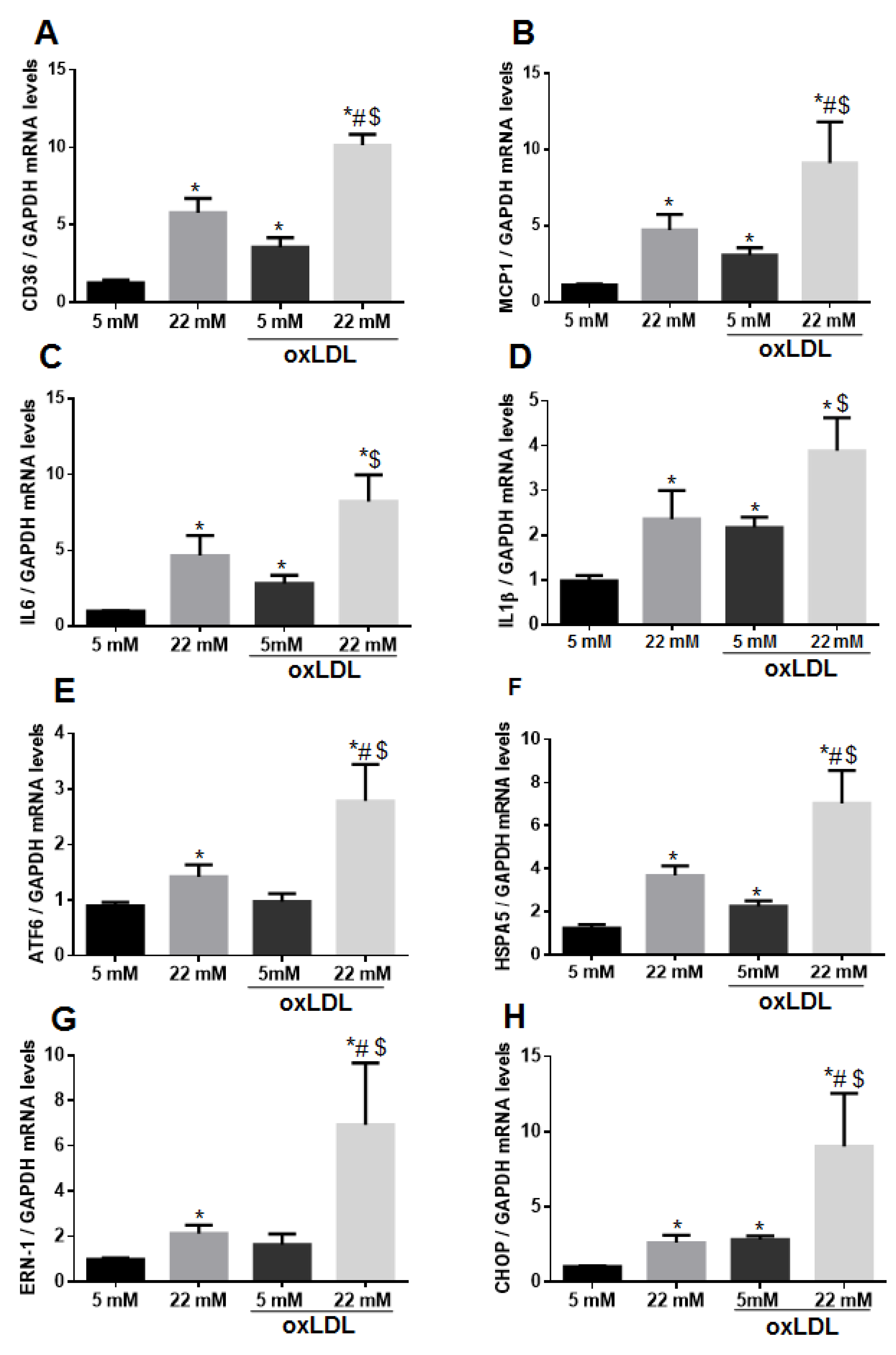
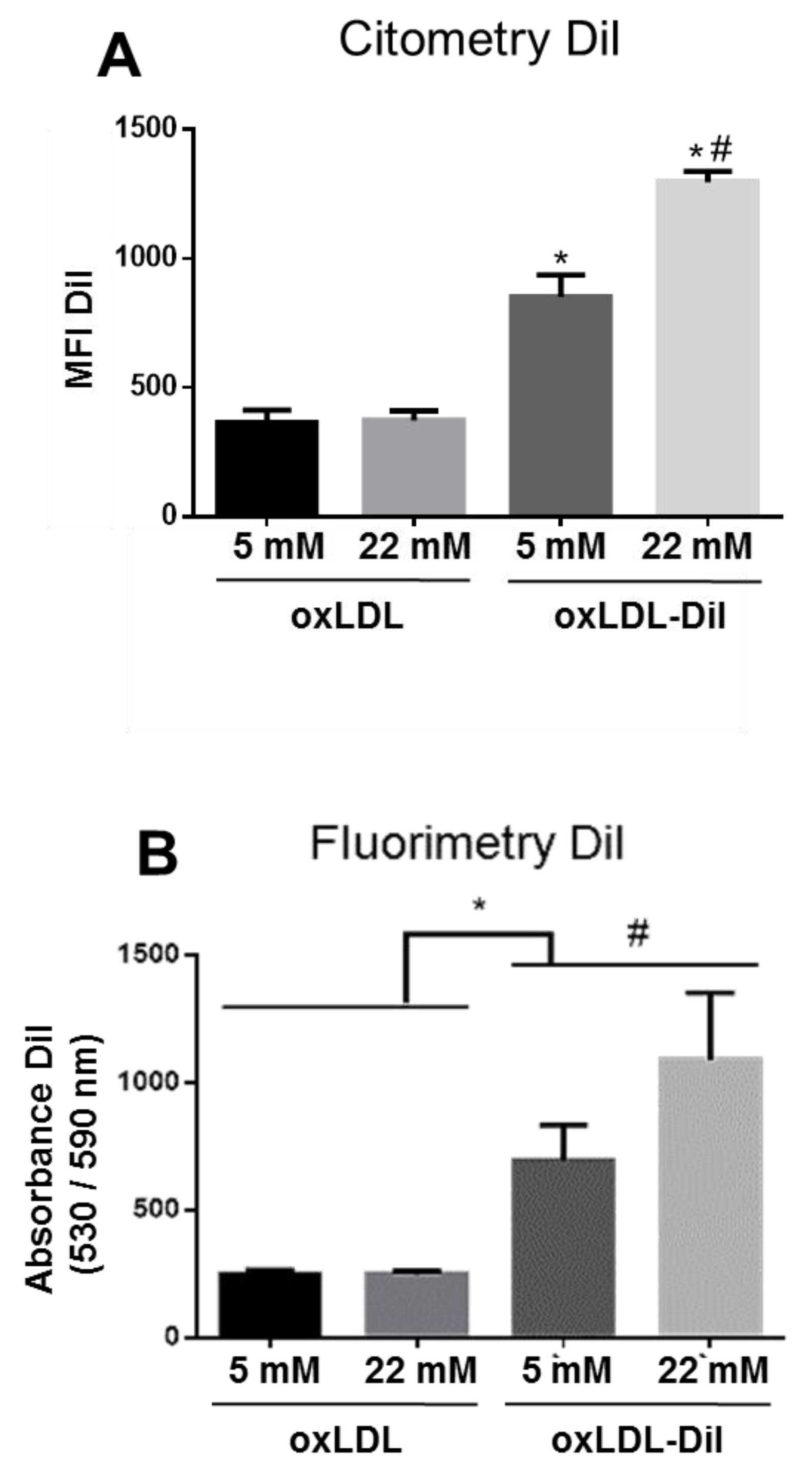
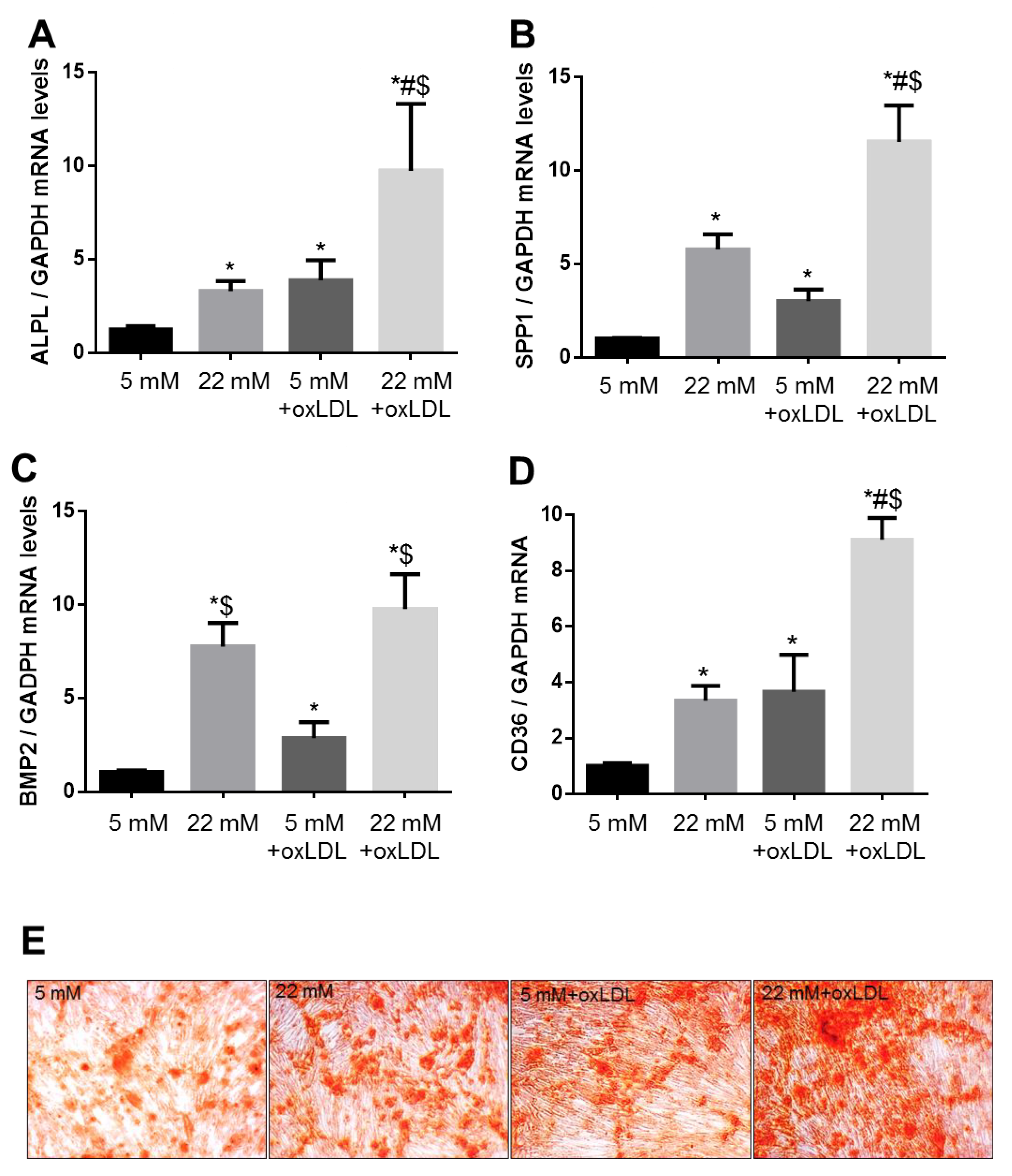
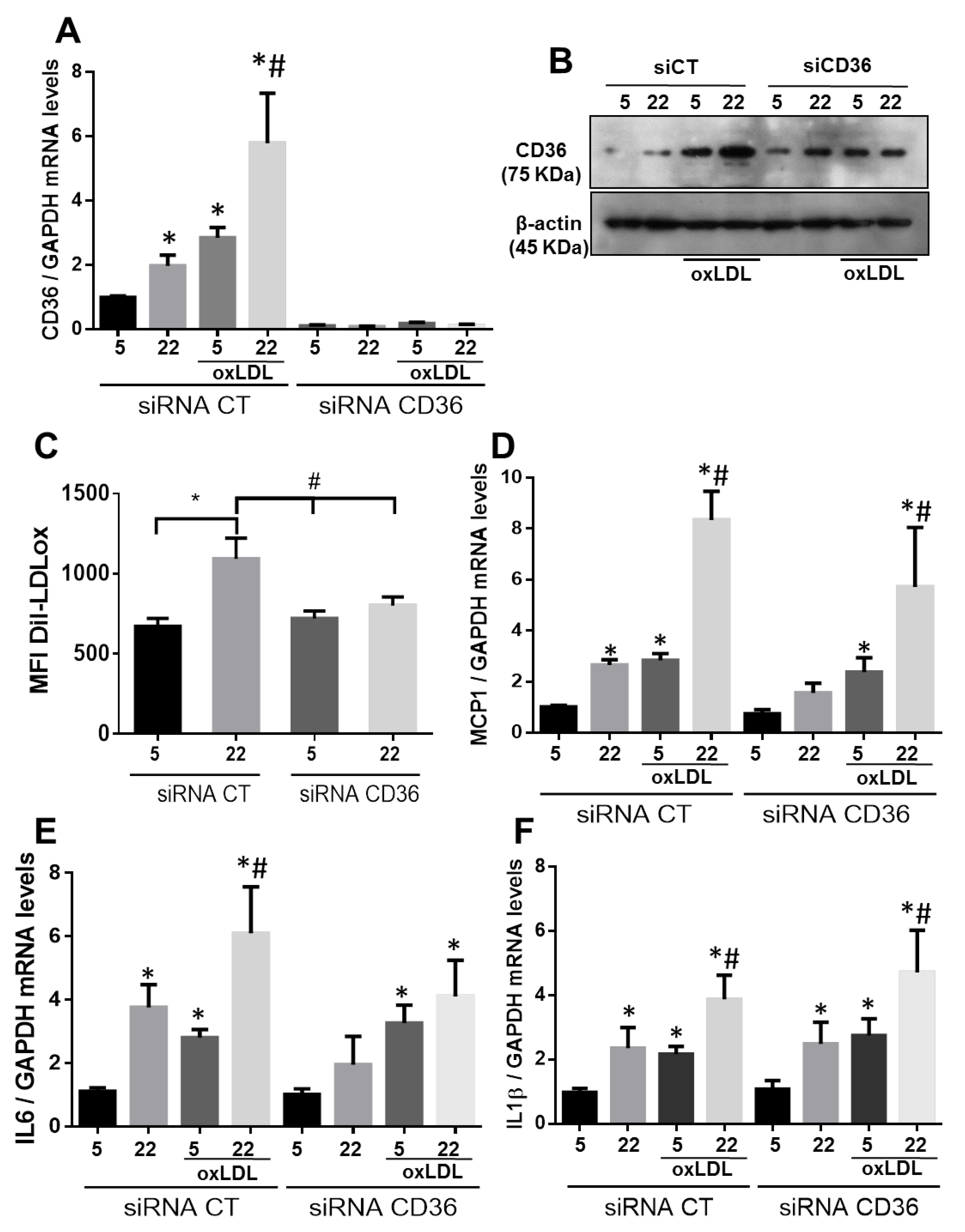
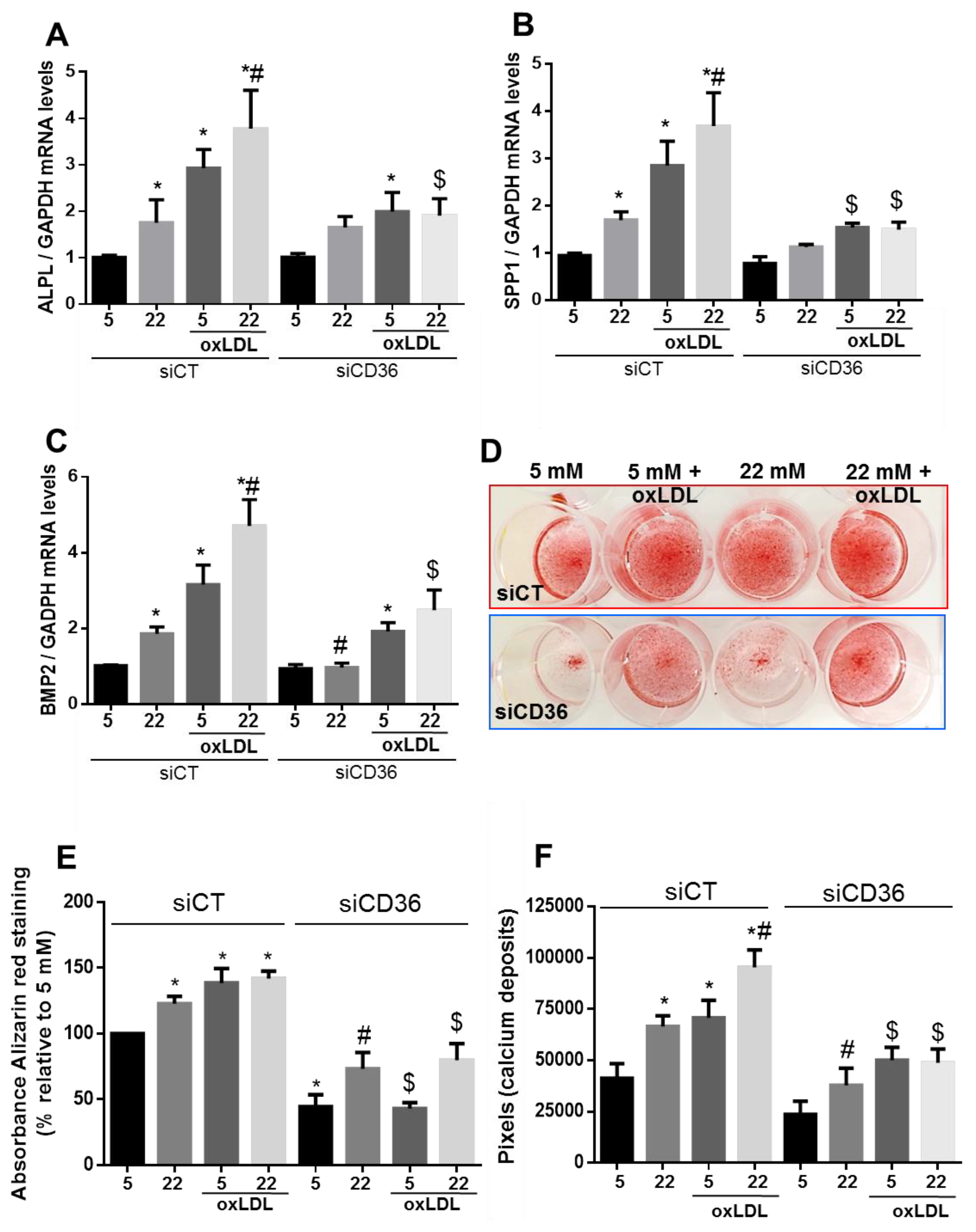
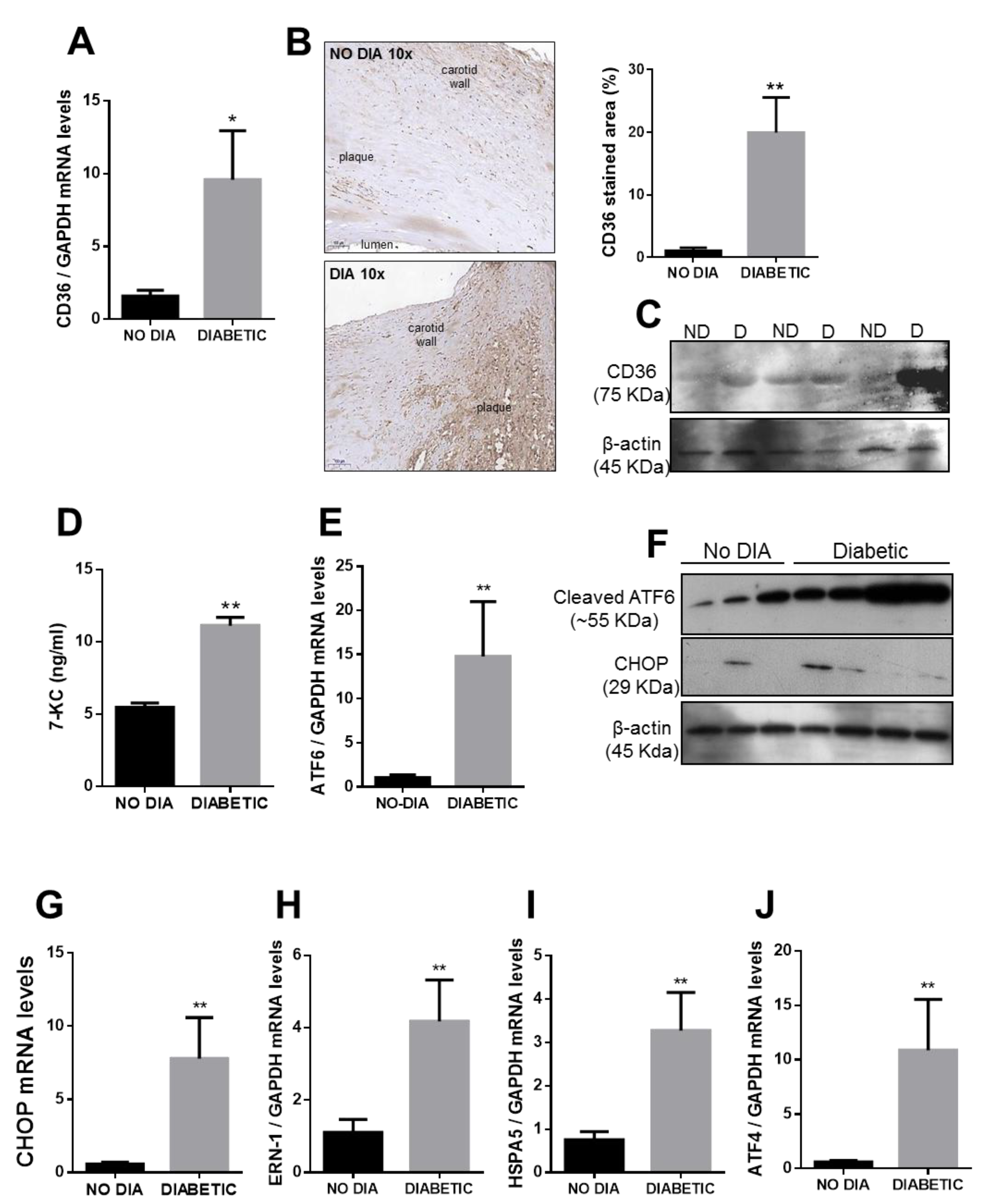
| No Diabetes n = 18 | Diabetes n = 18 | p Overall | |
|---|---|---|---|
| Sex, men | 16 (88.9%) | 16 (88.9%) | 1.000 |
| Age, years | 73.5 [68.0;79.5] | 76.0 [71.0;79.8] | 0.427 |
| Hypertension | 10 (55.6%) | 16 (88.9%) | 0.063 |
| Dyslipidemia | 16 (88.9%) | 18 (100%) | 0.486 |
| BMI, kg/m2 | 25.8 (3.47) | 27.4 (3.76) | 0.188 |
| Smoking: | 0.582 | ||
| No | 3 (17.6%) | 5 (27.8%) | |
| Yes | 4 (23.5%) | 2 (11.1%) | |
| Former smoker | 10 (58.8%) | 11 (61.1%) | |
| sBP, mmHg | 140 [130;148] | 130 [113;145] | 0.145 |
| dBP, mmHg | 78.7 (8.31) | 70.5 (11.7) | 0.022 |
| Antiplatelet treatment | 14 (77.8%) | 17 (94.4%) | 0.338 |
| Statin treatment | 16 (88.9%) | 16 (94.1%) | 1.000 |
| Glucose, mg/dL | 94.5 [85.0;111] | 133 [119;160] | 0.001 |
| Creatinine, mg/dL | 0.94 (0.39) | 0.98 (0.37) | 0.784 |
| eGFR, mL/min/173 m2 | 82.8 [60.5;90.0] | 79.0 [57.0;90.0] | 0.647 |
| ALT, U/L | 18.0 [16.0;30.8] | 20.5 [15.5;26.8] | 0.727 |
| GGT, U/L | 35.0 [17.0;52.0] | 23.0 [13.0;42.0] | 0.208 |
| Triglycerides, mg/dL | 86.0 [72.8;105] | 102 [81.0;142] | 0.227 |
| Total cholesterol, mg/dL | 138 [123;147] | 112 [102;125] | 0.028 |
| HDL cholesterol, mg/dL | 43.0 (11.7) | 39.7 (9.23) | 0.422 |
| LDL cholesterol, mg/dL | 80.0 [57.0;93.0] | 59.0 [45.0;73.0] | 0.099 |
| CRP, mg/L | 13.1 [2.20;21.3] | 4.76 [1.15;8.75] | 0.118 |
| Glycated hemoglobin, % | 5.70 [5.50;5.95] | 6.70 [6.12;7.50] | <0.001 |
| Glycated hemoglobin, mmol/mol | 39.0 [37.0;41.5] | 50.0 [43.2;58.0] | <0.001 |
| C peptide, nmol/L | 1.02 [0.90;1.64] | 1.17 [0.90;1.46] | 0.760 |
| Leukocyte count, ×109/L | 8.85 [6.68;9.53] | 8.20 [6.27;9.85] | 0.743 |
| Hemoglobin, g/dL | 13.0 (1.81) | 12.2 (1.32) | 0.152 |
| Hematocrit, % | 39.4 (5.51) | 36.5 (3.76) | 0.081 |
| Platelets, ×109/L | 195 (52.2) | 192 (41.5) | 0.882 |
| Albuminuria, mg/L | 20.4 [5.45;49.9] | 4.40 [2.70;24.4] | 0.174 |
| Albumin/creatinine ratio, mg/g | 13.9 [5.20;50.5] | 11.4 [3.80;24.7] | 0.765 |
| Diabetes duration, years | - | 12.2 (3.43) | - |
© 2020 by the authors. Licensee MDPI, Basel, Switzerland. This article is an open access article distributed under the terms and conditions of the Creative Commons Attribution (CC BY) license (http://creativecommons.org/licenses/by/4.0/).
Share and Cite
Navas-Madroñal, M.; Castelblanco, E.; Camacho, M.; Consegal, M.; Ramirez-Morros, A.; Sarrias, M.R.; Perez, P.; Alonso, N.; Galán, M.; Mauricio, D. Role of the Scavenger Receptor CD36 in Accelerated Diabetic Atherosclerosis. Int. J. Mol. Sci. 2020, 21, 7360. https://doi.org/10.3390/ijms21197360
Navas-Madroñal M, Castelblanco E, Camacho M, Consegal M, Ramirez-Morros A, Sarrias MR, Perez P, Alonso N, Galán M, Mauricio D. Role of the Scavenger Receptor CD36 in Accelerated Diabetic Atherosclerosis. International Journal of Molecular Sciences. 2020; 21(19):7360. https://doi.org/10.3390/ijms21197360
Chicago/Turabian StyleNavas-Madroñal, Miquel, Esmeralda Castelblanco, Mercedes Camacho, Marta Consegal, Anna Ramirez-Morros, Maria Rosa Sarrias, Paulina Perez, Nuria Alonso, María Galán, and Dídac Mauricio. 2020. "Role of the Scavenger Receptor CD36 in Accelerated Diabetic Atherosclerosis" International Journal of Molecular Sciences 21, no. 19: 7360. https://doi.org/10.3390/ijms21197360
APA StyleNavas-Madroñal, M., Castelblanco, E., Camacho, M., Consegal, M., Ramirez-Morros, A., Sarrias, M. R., Perez, P., Alonso, N., Galán, M., & Mauricio, D. (2020). Role of the Scavenger Receptor CD36 in Accelerated Diabetic Atherosclerosis. International Journal of Molecular Sciences, 21(19), 7360. https://doi.org/10.3390/ijms21197360







